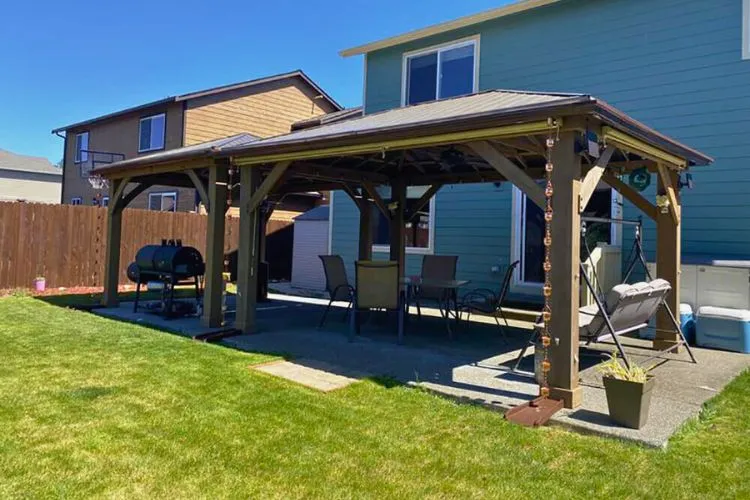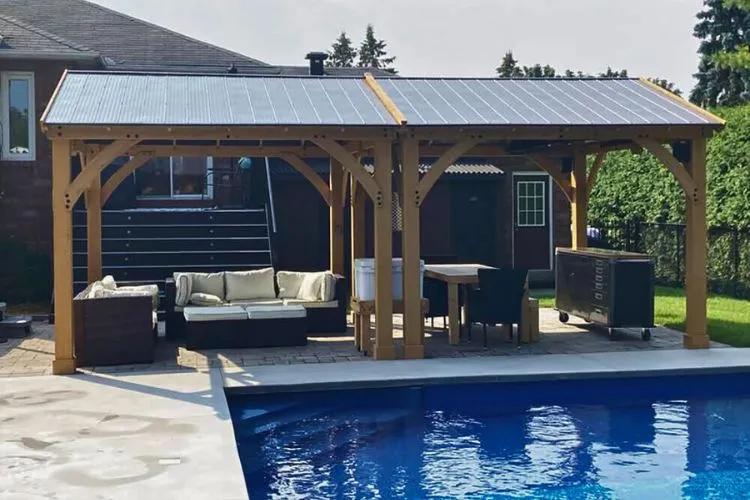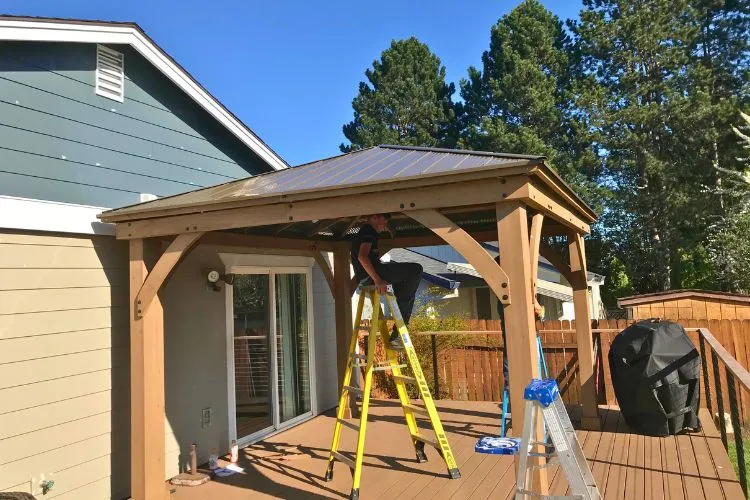When enhancing an outdoor space, joining two gazebos can be a transformative step. This strategy allows for a larger area to entertain guests, relax, or simply enjoy the outdoors under a protected cover. So,
The process requires thorough planning, precise execution, and an understanding of safety and legal restrictions. This article will guide you through each step on how to join two gazebos together, cohesive unit.

Contents
Planning Phase
Assessing the Gazebos
Before beginning any physical work, it’s critical to evaluate the compatible designs and materials of the gazebos to be joined. Both structures should be in good condition to ensure a seamless and safe connection.
If there’s notable disparity in design or material, this might complicate or even prevent joining them effectively.
Design Considerations
Choosing how the gazebos will be aligned involves deciding whether they should be positioned side-by-side or end-to-end.
This decision largely depends on the available space and the desired final layout. Ensure that the design flow remains consistent across both structures to maintain an aesthetic appeal.
Legal and Safety Considerations
Checking with local zoning boards or a city’s building regulations is essential to ensure the project complies with all local codes and safety guidelines.
Additionally, it’s crucial to consider the structural integrity of the combined gazebos. They should withstand weather conditions and be stable under load.
Preparation

Tools and Materials Needed
You will need a range of tools and materials to join the gazebos safely and effectively. Basic tools include a power drill, saw, wrenches, and possibly a hammer.
Materials might consist of bolts, nuts, heavy-duty brackets for structural support, and silicone caulk or similar sealing agents to protect against water ingress.
Site Preparation
The foundation where the gazebos will connect must be level and stable. If necessary, the ground may require leveling and possibly reinforcing. It’s imperative that the foundation can support the joint weight and dimensions of the new, larger structure.
How To Join Two Gazebos Together?
Structural Modifications
Modifications might be necessary on the structural elements of the gazebos to ensure a proper fit. Cutting certain parts to align or removing redundant components is often required. This step should be handled with care to prevent damage to the gazebos.
Securing the Gazebos Together
Mechanical Fasteners
Using bolts and brackets, secure the gazebos at different connection points. These should be distributed along the structure to spread the load evenly. Make sure that all fasteners are tightly applied and check for any movement or instability.
Sealing and Weatherproofing
After the gazebos are physically secured, apply silicone caulk or another appropriate sealant along the seams where the gazebos meet. This prevents water from seeping through the joints, which could cause damage over time.
Aesthetic Enhancements
Once the structures are securely joined, consider painting or staining the gazebos the same color to create a unified look. Adding matching shingles or roofing materials can also help blend the two structures aesthetically.
Finishing Touches

Landscaping and Decor
Plan the landscaping around the new gazebo structure to enhance its appearance and integration into the existing outdoor environment.
Use plants, stones, or other decorative elements to highlight the gazebo’s features and ensure it blends with the surroundings.
Safety Checks
Conduct a thorough inspection of the joined gazebos. Look for any potential weaknesses or unsafe conditions. Ensure every connection point is sturdy, and the entire structure can handle environmental stress like wind or heavy rain.
You may also read: How To Keep Water From Pooling On Gazebo?
Maintenance
Maintaining the joined gazebos involves regular inspections of all structural connections and protective coatings or sealants. Keep an eye on the wear and tear from the elements and address any issues promptly to prevent further damage.
Pros and Cons of Joining Two Gazebos
Joining gazebos increases outdoor living space and potential functionalities of your outdoor area. However, it can also introduce complex installation challenges and higher maintenance considerations.
Detailed Planning and Design
Customization Options
Customization plays a pivotal role in overcoming diverse landscaping challenges and catering to specific desires.

Creative customization can range from the architecture to the finer finishing details, ensuring that your joined gazebos not only meet functional needs but also reflect personal style.
From selecting materials that complement the natural surroundings to choosing unique roof styles or ornate fixtures, each decision tailors the space to individual tastes and functional requirements.
Integration with Existing Structures
Thoughtful integration ensures that your new, expansive gazebo harmonizes with nearby structures and the existing landscape.
This often involves matching architectural details, such as roof lines, color schemes, and construction materials, to create a seamless extension of your home or garden.
Proper alignment and transition are key to enhancing the natural flow of the space, establishing a design that feels intentional and effortlessly part of the original environment.
Technical Considerations
Load Bearing and Structural Integrity
Ensuring that the combined gazebo structure can support its own weight, along with environmental loads such as snow or people, is paramount.
Calculating load-bearing capacity involves understanding the strength of materials used and the distribution of weight across the structure.
Engaging a structural engineer could provide precise calculations, ensuring all parts of the joined gazebos maintain integrity and safety under various conditions.
Wind Resistance and Airflow
High winds can pose a significant risk to outdoor structures. Designing the joined gazebos with wind resistance in mind involves selecting aerodynamic shapes, securing all parts of the structure firmly, and using materials that can withstand strong forces.
Additionally, incorporating features for adequate airflow not only enhances comfort but also reduces wind pressure, ensuring the structure’s longevity in varying weather conditions.
Frequently Asked Questions (FAQs)
Can different types of gazebos be joined together?
Yes, but the process may be complex depending on the design and materials of the gazebos.
What is the most secure way to join two gazebos?
Using heavy-duty mechanical fasteners and ensuring proper sealing and alignment is essential for security.
How can I ensure the joined gazebos are waterproof?
Apply high-quality sealants at all connection points and ensure the roof materials overlap correctly.
Do I need a permit to join two gazebos?
This depends on local building codes. Always check with your local building authority.
How do I maintain the structural integrity of the joined gazebos over time?
Regular checks and maintenance of the structural connections and protective coatings are required.
Conclusion:
Successfully joining two gazebos enhances your outdoor living space both functionally and aesthetically.
With careful planning, appropriate tools, and an understanding of legal and safety standards, this project can provide lasting benefits to your home’s outdoor environment.
By following these guidelines, you can achieve a beautiful and functional outdoor space by successfully joining two gazebos.

Sergio Gomes, a passionate advocate for outdoor living and the male voice behind Shades Authority. With years of experience, Sergio is your trusted source for expert insights on gazebos, pavilions, cabanas, pergolas, and all things outdoor shade solutions. Join him on a journey to transform your outdoor spaces into stunning, functional retreats
